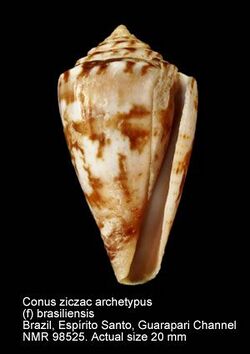Biology:Conus ziczac
| Conus ziczac | |
|---|---|

| |
| Scientific classification | |
| Domain: | Eukaryota |
| Kingdom: | Animalia |
| Phylum: | Mollusca |
| Class: | Gastropoda |
| Subclass: | Caenogastropoda |
| Order: | Neogastropoda |
| Superfamily: | Conoidea |
| Family: | Conidae |
| Genus: | Conus |
| Species: | C. ziczac
|
| Binomial name | |
| Conus ziczac Mühlfeld, 1816
| |
| Synonyms[1] | |
| |
Conus ziczac is a species of sea snail, a marine gastropod mollusk in the family Conidae, the cone snails and their allies.[1]
Like all species within the genus Conus, these snails are predatory and venomous. They are capable of "stinging" humans, therefore live ones should be handled carefully or not at all.
- Subspecies
- Conus ziczac archetypus Crosse, 1865 (synonyms: Conus archetypus Crosse, 1865; Conus bertarollae Costa & Simone, 1997; Conus brasiliensis Clench, 1942; Conus mauricioi Coltro, 2004)
- Conus ziczac ziczac Mühlfeld, 1816: synonym of Conus ziczac Mühlfeld, 1816
Description
The size of the shell varies between 8 mm and 9 mm. The rather solid shell is light yellowish-brown, ornamented with large irregular white patches, which are mostly longitudinally oblong and here and there zigzag. The patches at the angle are smaller and arranged in a regular way. The growth lines form slightly waved longitudinal striae, crossed by very faint spiral ridges, which become stout and prominent towards the base. The spire is broadly conical, but little raised, and rather sharply angled. The whorls are slightly concave above the angle, separated by a well-defined impressed suture, sculptured with three rather deep spiral grooves, and crossed by numerous rather prominent oblique striae. Interior of the aperture is pink.[2]
Distribution
This marine species occurs off the Bahamas and off Florida
References
- ↑ 1.0 1.1 Conus ziczac Mühlfeld, 1816. Retrieved through: World Register of Marine Species on 27 March 2010.
- ↑ G.B. Sowerby III, Descriptions of Five New Species of Shell; The Journal of Malacology v. 8–9 (1901-1902) (described as Conus beddomei)
- Mühlfeld, J. C. Megerle von, 1816. Beschreibung einiger neuen Conchylien. Magazin. Gesellschaft naturforschender Freunde zu Berlin, 8 (1 )
- Petit, R. E. (2009). George Brettingham Sowerby, I, II & III: their conchological publications and molluscan taxa. Zootaxa. 2189: 1–218
- Puillandre, N.; Duda, T.F.; Meyer, C.; Olivera, B.M.; Bouchet, P. (2015). "One, four or 100 genera? A new classification of the cone snails". Journal of Molluscan Studies 81 (1): 1–23. doi:10.1093/mollus/eyu055. PMID 26300576.
External links
- The Conus Biodiversity website
- "Purpuriconus ziczac" (in en). Gastropods.com. http://www.gastropods.com/3/Shell_24533.shtml.
Wikidata ☰ Q1602323 entry
 |

